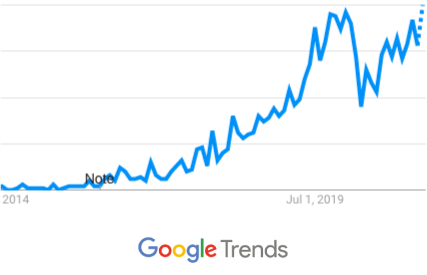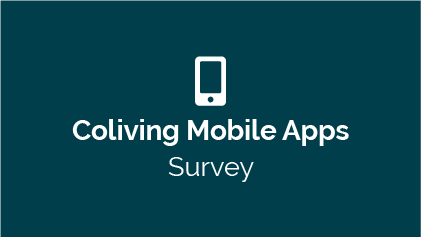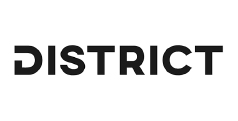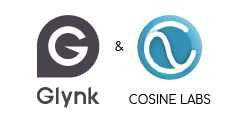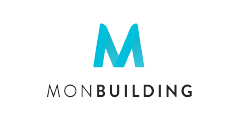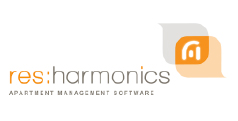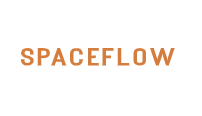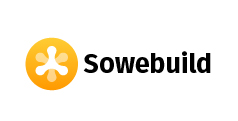Hi, welcome to the Coliving Apps, Software & Technology Guide!
This guide explores the most relevant software solutions to support coliving operators create thriving resident and community experiences.
Technology plays a key role in coliving – but how to pick the right solution? Let’s explore.
Coliving Apps & Tech 2021 Guide: Table of Contents
Add a header to begin generating the table of contents
Prelude:
The Vision for Coliving Spaces
As key players of the fast-growing global coliving movement, coliving operators are pioneering the way towards a new living paradigm that is already unfolding. This is the paradigm of collaborative thriving. Around the world, there is forming an extensive network of thriving coliving communities that facilitate the flourishing of each individual and the collective.
A thriving community is one that
facilitates the flourishing
of each individual and of the collective.
More specifically, this means that the design, the communications, the events, the food etc., of each coliving space are all geared towards nurturing the highest potential in each human as an individual and the community as a whole.
However, for this to actually be possible, especially at scale, technology must come into play. In the words of coliving operators:
Technology
facilitates the best experience for residents
and smooth operations for the operator.
Yet, exploring and choosing among all the technology solutions for a coliving space can feel overwhelming, frustrating, and confusing. This guide has been created to help coliving operators navigate the realm of coliving technology. We welcome any input to make this Guide as useful as possible, so that it is truly co-created by the coliving industry for the coliving industry.
And, we have great news for you: There are very passionate and caring technology developers out there. They have wonderful teams that have your best interest as a priority. It is all about being curious about what is possible, to then find the right fit.
Now is a great time to explore what technology is out there technology to create your own thriving coliving community and business. So, before we dive into the range of apps, software and other technology solutions, let’s zoom out and explore the context.
Section 1:
The Context for Coliving Apps, Software & Tech
The Global Coliving Trend
Google searches for coliving have been rising since about 2015. Meanwhile, global funding for coliving has also increased by more than 210% annually since 2015, totalling more than US$3.2 billion.
While the impacts of Covid-19 have been felt, coliving has proven to be a particularly resilient industry.
The pandemic has also accelerated the adoption of new digital solutions for real estate and coliving. VCs invested $23.8 billion in real estate tech in 2020. Plus, many traditional PMS (property management systems) platforms have started offering solutions tailored specifically for coliving spaces. In summary, this is all very exciting!
For a deeper analysis of the meaning of coliving, check out the Coliving 2022 Guide.
What Does the Coliving Industry Want?
One of the polls run at the Co-Liv USA Meetup in February 2021 asked: “Which topics interest you the most?“. As shown in red, “Technology and digital tools” was the top priority, with 52% of votes.
While we were already working on this Guide project at this point, this insight (thank you Co-Liv 🙏 ) motivated us to assign additional time and resources to it.
In addition, you can see in this poll from the Co-Liv Summit this May asking the same question. The poll shows similar results, with ‘Digital’ and ‘Community’ coming out on top at 15% each. There were 167 respondents for this poll.
To point out: “Community facilitation” (39%) is another trending topic.

We explore this in-depth in The Community Facilitation Handbook v1.0, a co-creation with Art of Co. This guide expands on The Handbook by exploring how apps and tech can enhance resident and community experience.
And, in terms of “Environmental sustainability and social impact” (39%), make sure to explore the “How to embed ESG & social value in shared living” Webinar here. Now, let’s get back to the main topic at hand and explore how technology and digital tools can be used for coliving.
How Can Apps & Tech be Leveraged in Coliving?
Technology can help overcome common coliving challenges and facilitate thriving coliving spaces. To list them, here are 8 ways technology enables this:
- Making operations more efficient
- Helping understand resident needs
- Enabling more monetization
- Facilitating connection between residents, staff and the wider community
- Supporting a sense of “homeyness”, safety and comfort
- Enhancing wellbeing initiatives
- Fostering sustainable behaviour change
To be sure, we are NOT saying that technology is the single answer to building and sustaining community. As the Sowebuild team would say:
It takes
patience and dedication to build community in co-creation with your members.- Rick Schols & Sander Willems, Sowebuild
Undoubtebly, this is an important point to keep in mind while reading this guide. However, when used well, we believe that technology makes a difference in enhancing resident and community experience. In the next section, we highlight some of the research we have been carrying around coliving and tech.
Section 2:
Coliving Apps, Software & Tech Research
The research behind this Guide was carried out by Conscious Coliving co-founders: Naima Ritter Figueres (Head of Community & Wellbeing), Juan Ortiz (Head of Comms & Tech) and Matt Lesniak (Head of Impact & Innovation), with support from the wider coliving community.
We intentionally put ourselves into the shoes of coliving residents and operators to understand the most relevant tech-related needs. The research has so far been sourced from a significant amount of desk-based research and:
- Conversations and demos with 15+ coliving software providers
- The Coliving Mobile Apps Survey with 30+ responses from coliving operators and follow-up conversations with several of them
- Contributing to Coliving Insights N°5
- Conversations with other players researching tech related to coliving
We look forward to this collaborative research continuing to evolve and expand.
The Coliving Mobile Apps Survey
The main aim of The Coliving Mobile Apps Survey is to understand how coliving operators are currently leveraging mobile apps to enhance resident and community experience.
The survey is a collaborative effort between Conscious Coliving, Co-Liv and Coliving Insights, as well as the 32 operator respondents.
You can find a summary of the main survey outputs on the results page.
Coliving Insights N°5
Coliving Insights N°5, titled “Co-Tech: Innovating Coliving with Technology“, includes several articles on resident and community experience covering topics such as digital experience, online and offline communities, and tech to improve human dynamics.
You can explore all the Coliving Insights publications here.
Additional Real Estate & Coliving Technology Research
In addition to the above research, we list a few additional resources below.
Additional Real Estate & Coliving Technology Research
- Obeyo has carried out research with over 50 operators regarding technology for building engaged communities. They have developed a Community Strength Index for operators to self-assess and track performance across four key components:
- 1) member acquisition
- 2) onboarding
- 3) engagement
- 4) operations
A corresponding template helps operators find the right tech for scaling their coliving business.
- Smart coliving: Technology and coliving: This Coliving from the Trenches article discusses how to use technology such as chatbots and IoT sensors to optimize your coliving space, measure KPIs, and gamify your data.
- The Case for Coliving PropTech Investment: This article discusses how coliving offers a compelling case for new digital tools. It offers insights into the current digitization of the real estate industry and Software as a Service as a key investment category for coliving.
- The Co-Liv Summit is a yearly gathering of coliving professionals from around the world to exchange, learn, and connect. In 2021, the Summit included several sessions on software and technology, including “Tech in PBSA vs Coliving” and “The Role of IoT in Coliving”.
- The Coliving Code is a Youtube channel in which Christine McDannel, founder of Kndrd.io, interviews leading pioneers shaping the coliving movement. Several of the videos highlight the role of software and technology in coliving, such as this one from the Global PropTech Panel.
- Coliving Ecosystem Report co-created by Conscious Coliving and SALTO Systems.
- CBRE PropTech Index 2019 is a report which explores tenant’s digital needs and how technologically advanced office buildings are. The CBRE PropTech Blog is another useful resource.
- 2020 Technology Outlook Report by Cushman & Wakefield outlines how investors and developers can capitalise on software, technology, and PropTech in general.
It is through all this collaborative research that we have been able to identify key features. These features in software, apps, and technology help facilitate thriving coliving communities.
Let’s dive into these in the next sections.
Section 3:
What is the Ideal Coliving Techology Solution?
Spoiler alert: there is no one ideal coliving software or technology solution.
Indeed, there are many options. Operators have different needs and types of residents, so whatever tech solution/platform is used by one operator may not be the best for another.
However, several key features have been commonly identified to help create an excellent experience for both coliving residents and operators. The following sections present an overview of these features as well as some core software apps that cover these features.
But, first, we invite you to join us on a short thought experiment.
A Day as a Coliving Resident
Step into the shoes of a coliving resident for a moment:
What could a day look like in your tech-empowered coliving community?
Imagine you…
- 6:30: Take a morning shower and see that you only used 22 litres of water
- 7:00: Receive the morning air monitor report saying the air quality is healthy and virus free
- 7:30: Use your phone to scan into the morning meditation + stretch session
- 8:30: Use the community currency to pay for a breakfast smoothie
- 9:00 Scan into the co-working space with the resident app
- 13:00: Easily split the lunch bill with your co-creators via your app
- 15:00 Get a notice that your monthly rent has been withdrawn
- 16:00 Propose to exchange an hour of coaching for a massage in the community marketplace
- 17:00 Get a notice from maintenance that the bathroom leak has been fixed
- 19:00 Order food delivery with your 15% member discount
- 19:30 Reserve a spot for Wednesday’s community circle via the app
- 22:00 Check out local weekend events and invite your friends to join via the app
This kind of resident experience can be enabled by a variety of software, apps and specific features. We explore these below.
The Key Features for Enhancing Resident & Community Experience
Based on our software, apps and technology research, we were able to decipher a set of key features (for both residents and staff) that help facilitate the best resident and community experience. The table below categorizes these features according to their use by residents and/or staff.
Key Residents Features
- Onboarding support
- In-app payments
- Community feed/forum
- Chat for residents
- Resident directory
- Resident-led events
- Polls and feedback channel
- Groups
- Digital key & access
- Notifications / announcements
- Booking spaces & amenities
- Additional services
- Important documents and resources
- Local tips, news, & events
- Resident-led marketplace
- Food & beverage services
- Local partnerships & discounts
- Sustainability features
- Incident reporting & tracking
Key Staff Features
- Onboarding automation
- Payments system
- Events management
- Admin dashboard / console
- Reporting & analytics
- Polling system
- Additional services directory & management
- Booking system (spaces & amenities)
- Incidents ticketing system
- Staff access
- CRM system
- Content Management System (CMS)
- Sustainability measurement
- Wellbeing measurement
- NPS & customer satisfaction measurement
- Building management
- Investor dashboards
To point out, one key tip shared by many of the operators we spoke to was: “Don’t add features’ for features’ sake“. It is easy to get excited about options but also overwhelmed by too many features. This is important to keep in mind, especially as we explore the role of APIs and integrations.
What are APIs and Why are They Important?
Application Programming Interfaces (APIs) are the enablers of collaboration in the world of technology.
There is no one do-it-all coliving software solution that perfectly fits all types of coliving business models. However, API-enabled integrations can help operators combine the strengths of different platforms.
To illustrate, below are some of the many benefits of software platforms that provide API integrations:
- Platforms that are part of your coliving technology stack can access and use other features
- Ensure secure transmission of data between platforms
- Provide a single app for your coliving residents, simplifying and enhancing their experience
- Optimise, automate and simplify processes to scale your coliving community
SaaS vs. In-House Software Development
Leveraging technology in the right way and at a manageable cost is a common challenge across industries, including coliving.
As an operator, it’s likely you have already asked this question: Should we develop our own coliving technology and software?
In most cases, the answer is no.
At the present time, there are many great Software As A Service (SaaS) options for coliving operations. Many of them have been built specifically for coliving communities, while others have been successfully adapted from other industries. This Guide will explore SaaS options available for you.
Should I build my coliving software in-house or hire a Saas provider?
Building an in-house app or software is a complex and expensive process that requires dedicated staff.
Years ago, off-the-shelf software and technology used to be expensive and clunky. Therefore, it used to make sense to opt for custom developments. By comparison, if you go down the Software as a Service route, you can partner with someone already offering what you need. You do not need an internal team dedicated solely to developing and maintaining the technology.
Today, there are many cloud-based software options available for coliving communities, and more are currently being developed. However, these need to be adapted for your specific objectives.
These articles can support you on further exploring Software as a Service vs custom development:
When does it make sense to build my own in-house coliving technology?
In our view, it only makes sense under two circumstances:
How can I scale my coliving space with the right SaaS system and integrations?
In their article titled “When and how to scale your space with the right integrations,” Christian Schmitz and Kristin Pater offer some pointers for when researching a system to host your integrations:
- Often overlooked, but highly important: choose a system that is supported in your country (especially when there is hardware involved);
- Pick ‘out of the box solutions’ to hit the ground running when you are just starting;
- Choose systems that support future scenarios and can scale with your business.
What Software as a Service Cover These Features?
Because coliving is such a new industry, the market has largely been missing dedicated and purpose-built coliving technology. Most of the initial software options came from traditional hospitality, rental or co-working sectors. These were great solutions in some cases, but generally, they lacked a community and coliving focus.
However, there are now several coliving-focused software options from well established and new technology providers. Many are available already, while others are still in beta or have not launched… yet.
This Guide presents the most relevant apps for coliving based on the most closely associated sector from which they come or have been adapted. Of course, as the coliving software field evolves, this coliving technology guide will evolve with it.
Section 4:
Property Management & Community Building
One reason you as a coliving operator may not be finding the ideal technology solution is that your starting points are either property management or community building challenges. Why did we combine both in this section? Because at the core of running a thriving coliving operation, you’ll need both. Let’s explore below.
Property Management Systems (PMS)
A PMS is a software solution that provides a centralized computer system to organize, schedule and perform the day-to-day functions and transactions involved in real estate businesses. Functions of a PMS might include building info, bookings, check-in and check-out, event management, housekeeping, inventory supply management, managing security and room locks, and more.
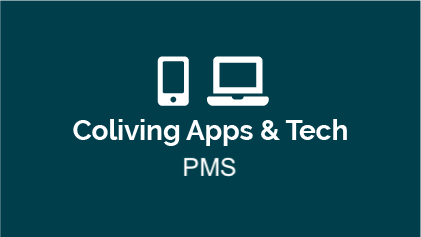
According to the Coliving Mobile Apps Survey results:
- 75% of respondents say they want payments and billing as an app feature
- 90% say they want announcements and notifications as an app feature
- 90.63% say they want incident reporting and tracking as an app feature
Several PMS options on the market do include these kinds of features, which are critical for the smooth operation of a coliving space. However, operational and management features are only part of what a thriving community needs from a software platform: community features are also necessary. We share below some of the technology solutions we came across in our research that are great as a PMS option but lack community features.
Property Management Systems without community features
- ColivHQ is a simple software to manage coliving businesses and includes features such as a members CRM, lead capture and management, maintenance issue tracking, and billing. This coliving technology currently does not offer a tenant app.
- FieldCircle describes itself as an all-in-one software suite that equips businesses to manage their service operations effectively and deliver a better customer experience while increasing profitability. While it has a customer app, most of FieldCircle’s software features primarily focus on operations via a desktop platform. The app only allows users to initiate service requests, check historical logs and invoices, and rate technicians and leave feedback.
- Property Apps is a cloud-based property management toolbox for property managers to manage all properties from a single place. The software offers features for tenants, but these are limited to a communication channel and profile of each tenant. Property Apps does not currently offer a resident app.
- Yorlet is a technology company that builds payment tools for real estate. Their software is used by small and large developers and operators in the coliving and BtR sectors to automate leasing and payment, process rental applications, and manage their business online. This coliving technology does not offer a resident app.
Community Building & Facilitation
Community apps are typically designed to help community members engage, share content, discuss topics, and organize events.
In other words: tech-empowered community building and facilitation!
According to the Coliving Mobile Apps Survey results:
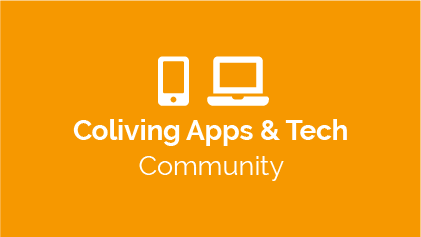
- 87.5% of respondents say that they want resident-led events as an app feature.
- 93.75% of respondents say that they want community groups as a feature.
- 78.1% of respondents say that they want polling as a feature.
Several community apps on the market include these features but are geared for online communities, not physical coliving spaces. We share some of these from our research below.
Apps for online communities, but not ideal for coliving
Empact: a white-label community platform and mobile app designed to ignite collaboration and drive meaningful engagement. Is a partner of the UN 2030 Agenda for Sustainable Development and Climate Change.
Commsor: a software platform that allows community managers to integrate, manage, understand, and measure their communities across all tools and channels into one place. They have an extensive ecosystem mapping of community tools which can be found here.
Disciple: white-labelled community platform aimed at those who want to build online communities. The management console allows one to publish content with scheduled posts, set up member profiles, and better understand the community through analytics.
Hivebrite: a software platform with tools to build, manage, and engage online communities. It offers a customized platform, engagement measurement, communication channels, event management and online payments.
Tribe: a cloud-based community platform for building integrated and branded communities. Its features include virtual currency, analytics, and gamification.
Circle: a white-labelled community platform for creators that brings users together through
There are also community apps for physical communities (e.g. neighbourhood apps) which are not designed for the management/operations of property. As such, there is a need to integrate the features of both property management and community apps. discussions, memberships, content, and direct messaging.
PMS & Community Building Solutions
This section will share with you eight software providers that offer features covering both PMS and community angles. The majority of these also allow for integrations with other software to create a complete solution through APIs.
Some of the benefits of this kind of combined PMS + community technology are:
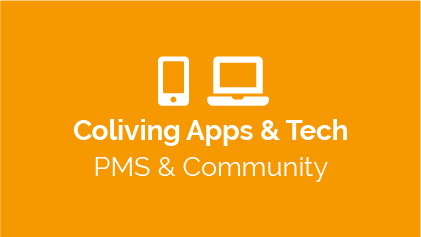
- Simplification and reduction of tools by keeping them all in one place
- Enhanced resident experience through fewer hassles, easier collection of payments and smoother service
- Activation of residents through engagement-oriented features
- Enhanced staff experience through reduced roadblocks for the team and easier transactions with residents
- Increased efficiency and optimized workflow through automation of repetitive tasks
- Improved transparency by keeping track of issues and progress of solutions
- More effective decision-making and improved collaboration possibilities
- Reduced risk with features that safeguard your space and community
- Increased visibility via a branded portal for residents
- Additional revenue stream through monetizing your building system
- Enables space-as-a-service
- Enriched connections with local neighbourhood actors
- Data-driven decisions
The coliving technology providers currently included (in alphabetical order) are:
District Tech, Glynk & Cosine Labs, MonBuilding, res:harmonics, Spaceflow, Sowebuild and TheHouseMonk. We will add more in the future as this guide continues to evolve. Below we offer a snapshot of these software providers, indicating with icons when features can be used on mobile, web or both.
District’s smart community platform builds upon an existing coliving experience through a digital layer. It features member events, concierge, relevant news, services, perks and more. District can also integrate with smart building technology and has an open API.
Key Residents Features
- In-app payments
- Community events
- Chat for residents
- Community newsfeed
- Resident directory
- Booking spaces and amenities
- Resident concierge
- Community events
Key Staff Features
- Building management
- Admin dashboard
- Reporting and analytics
- Events management
- Content management
- Contact tracing
- Concierge management
- Admin dashboard
Glynk (a SaaS-based community relationship management software) and Cosine Labs (a patented IoT platform that automates operations and building management via hardware and software solutions) have recently joined forces. Together they help build secure, scalable and engaged communities. Glynk partners with TheHouseMonk for payments and complaints.
Key Resident Features
- Resident profiles
- Community feed
- Groups based on interests
- Polls & Announcements
- Partnership with local spaces
- Remote door lock/unlock
- Smart energy monitoring
Key Staff Features
- Admin dashboard
- Incidents tracking system
- Attendance tracking
- Access management
- Preventive maintenance
- Multi-property real-time management via a single dashboard
- Rules engine for workflow
- Incidents tracking system
Monbuildling is an all-in-one building app for improving communications, fostering community, and enabling access to services to all occupants. As tenant experience specialists, MonBuilding offers customization and white-label options for operators who want to create a bespoke app for their residents. They also offer a highly customizable marketplace, integrating third-party APIs and payment management in the app.
Key Resident Features
- Booking
- In-app payments
- Customizable marketplace
- Space & amenities booking
- Resident directory
- Community feed & messaging
- Incident reporting
- Polls
- In-app payments
Key Staff Features
- Building/property management
- Admin dashboard
- Onboarding & electronic contract signing
- In-app rent payments
- Reports & analysis
- Events management
- Services directly
- Ticketing system
- Admin dashboard
res:harmonics is a software platform for short stay and long stay residential communities. A cloud-based PMS guided by an open-API approach, res:harmonic’s range of fully-customisable software features and consultancy services helps operators optimise and maximise sales, enhance guest experience, streamline operations and reduce costs. res:harmonics is also launching a white-label guest app specifically for coliving.
Key Residents Features
- Automated payments
- Contactless access / check-in
- Comms platform
- Guest portal / info hub
- Real-time incident reporting
- Personalisation of stay
- Contactless access / check-in
Key Staff Features
- Dashboard & reporting
- CRM embedded in PMS
- Channel manager
- Owner portal
- Unified inbox & availability grid
- Quote portal & direct booking
- CRM embedded in PMS
Spaceflow creates digital experiences to enable better life in buildings. Integrating data, technology, and people, Spaceflow provides an all-in-one solution with four main parts: an operating system, an admin dashboard, a tenant experience mobile app, and community management tools. The software platform is present in 17 markets, including the UK, the US, and DACH, Benelux, and Scandinavia.
Key Residents Features
- Smart building features
- Visitor management system
- Spaces/amenities booking & payments
- Issues reporting
- Resident chat & events
- Services & perks
- Posts & polls
- Digital concierge
Key Staff Features
- Dashboards & analytics
- Features configuration
- Visitor management system
- Reservations
- Content management system
- Tenant & services directory
- Customized building profile
- Polling system
- Features configuration
Sowebuild is a community engagement platform that offers tailor-made consulting and community building solutions. Their Buildr Apps solution offers a white-label web application including a mobile app that tenants and community managers can use. API integrations allow Sowebuild also to offer space access control, occupancy and visitor management, and a building and intercom systems.
Key Resident Features
- Community feed and messaging
- Calendar & events
- Private Member Chat
- Live Polling & Surveys
- Resident-led Marketplace
- Groups and categories
- Space and amenities bookings
- Local commerce
- Digital payments with tokens
Key Staff Features
- Member management
- Bookings Management
- Residents Directory
- Building Information
- Incidents ticketing system
- Smart Scheduling
- Smart chat
- User engagement analytics
TheHouseMonk is a central and comprehensive management software platform for rental real estate, including coliving. It offers end-to-end management solutions for property management, facility management, and tenant experience management. An open API approach also includes customizable and white-label options. TheHousemonk has multi-currency and multi-lingual features and is already being used by 100+ real estate businesses across 15 countries.
Key Residents Features
- Custom branded tenant portals
- In-app payments
- Resident-led events
- Community feed and messaging
- Booking spaces and amenities
- Incident reporting
- Offers & coupon section
- Contactless document sharing
- Parcel and visitor management
Key Staff Features
- Custom property listing portal
- Booking management
- Admin dashboard
- Move-in and out management
- Reporting and analytics
- Events management
- Payment system
- Services directory
- Incidents ticketing System
As mentioned above, this section will continue to expand moving forward. If you have any other software solutions that would make this Guide even better, do get in touch 🙂
The remainder of this section explores some of the most common questions you might have while exploring PMS and community building software solutions for your coliving community. In particular, we want to save you time since we already did a lot of the research that you might otherwise do!
Which PMS + community app solutions are in beta?
- Obeyo: an all-in-one coliving operating system designed to offer virtual tours, online booking, digital check-in, onboarding, check-out, etc. They are also creating an app for tenants to simplify coliving life and serve as a channel for connecting with the surrounding local neighbourhood and city.
- Wicomico is currently still in beta version, but Plushusene is already using it in Denmark. The app helps operators optimize operations, create additional revenue streams, and develop stronger communities. It includes a bulletin board, events, payments, incident reporting, and booking of spaces and services.
- Proptiq is a platform that offers coliving spaces to use their branding and digital solutions for various aspects, including digital access, services, community management, and rental automation. Proptiq is currently working on a community app.
Which coliving operators have built their own coliving app in-house?
Some of the operators that we know have built and are using their own app are as follow:
Section 5:
Other Key Areas where Tech can Support Coliving
This section gives an overview of additional coliving software and technology. You can either use these on their own or via an integrations using APIs.
Security & Digital Access Control
Simple and easy building access and movement is critical for creating the best possible tenant experience.
Digital access and key management technology enables this. Benefits of integrating such a solution include:
- Increased security
- Enhanced feeling of safety for residents
- Automated check-ins
- Covid-smart deliveries and access
- Reduced inefficiencies
- Activity analysis and insights
There are several technology providers that offer digital key management for enhanced security and access features.
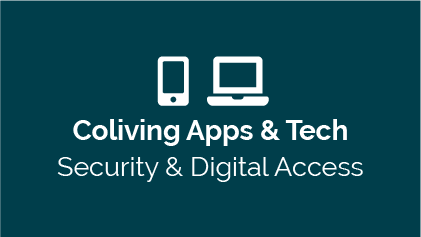
71.88% of coliving operator respondents say that they want a digital access solution for their coliving buildings.
- Coliving Apps & Tech 2021 Survey
We would first like to highlight SALTO KS, the access control solution from SALTO Systems, an active participant and supportive partner in the coliving community. SALTO Systems is a key access control player that offers cloud-based access control for a coliving spaces, serviced apartments, and purpose built student accommodation via digital keys. Their technology also offers extensive integrations options and easy ways to analyze valuable data and customer behavior.
Other digital security and access solutions are listed below.
Security & Access Control Solutions that can be explored
There are many other access control technology solutions we explored while creating The Apps & Tech Guide. Here are some:
- Assa Abloy is a global provider of security technology. While they do not focus on coliving, Node Coliving is currently integrating the platform’s features into its own Node app. Assa Abloy offers simple electronic locks and fobs to full integration solutions with mobile device access and cloud-based administration and monitoring. The platform offers its technology solutions on a modular basis according to the needs and scaling plans of its users.
- Akiles is an access management software that offers a wireless network between devices to allow remote and scalable management of spaces. An unlimited amount of virtual keys can be created and shared via email or link. Permissions and restrictions can be created by limiting the access and validity of the virtual keys based on time and location. Akiles offers an easy-to-use API for integrating with other software. Enso Coliving is currently using Akiles.
- Kisi is an access control solution including touchless door access with smartphone digital keys, contactless elevator access, thermal scanning integrations and health and occupancy control. Admins can grant or revoke access and monitor events remotely, while residents can use their phones to unlock any door. Kisi has extensive integration with other platforms.
- Latch App is a full-building operating system including an app for residents and a management tool for property managers. Its features include smart access, guest management, delivery management, and smart home sensors. The Latch Manager tool offers a dashboard of buildings and staff, access monitoring for entrances and common spaces, and easier onboarding. Latch also offers a range of integration capabilities and is currently being used by SharedEasy.
- Tapkey is an access platform for property management, car sharing and delivery. It offers a range of electronic locks that users can manage via their smartphones. Digital keys can be issued, revoked, and restricted according to specific times and locations. Tapkey also offers a range of integration options for hardware manufacturers and system integrators.
Coworking
If your coliving community has a small or non-existent coworking space, then this section is irrelevant for you. However, if you have large, dedicated operations, including adding a dedicated coworking space/spaces, you will want to have software supporting you.
Coworking apps can enable you to:
- Streamline and simplify membership management
- Automate daily tasks and processes such as billing and accounting
- Book out, manage and keep track of meeting rooms and equipment
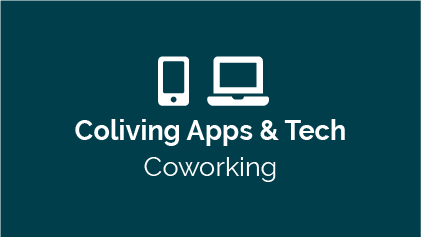
The global coworking space market is expected grow from $7.97 billion in 2020 to $8.14 billion in 2021
- Coworking Space Global Market Report 2021
Some of the PMS and community apps mentioned above already include coworking features. Indeed, we highly recommend that you not have separate coliving and coworking software solutions as it’s best to have one technology solution that covers both (see Section 4 for eight featured apps which do this).
However, we share some of the coworking apps that we came across in our research, should they offer a source of inspiration.
Coworking apps that can be explored
- Cobot is a leading coworking space management software solution and white-label platform. It helps automate processes such as invoices and payments and streamline onboarding. The platform also allows users to book conference rooms and equipment while keeping track of time and usage.
- Coworkify is an app that facilitates managing membership and back-office tasks for any coworking space. Their technology handles booking, sales and marketing, payments and invoicing. Users can also use the tool to create a front end for your website.
- Nexudus is a white-label software that automates daily tasks and processes, such as bookings, accounting, access control, and lead and member management. Its features help members create connections among themselves, book resources and manage their accounts online. Nexudus offers both a members portal and a mobile app.
- OfficeRnD is a management software for coworking and flex spaces. It enables operators to automate administrative processes, make data-driven decisions, and deliver a smooth member experience.
- YaRooms is a booking app for meeting and conference rooms. It allows users to book spaces from their phone, tablet, online, or through Outlook. Users can also install the app on a tablet outside the door of conference rooms to allow colleagues to book themselves and their team into an open room quickly.
Sustainability
If your coliving space doesn’t yet incorporate environmental sustainability features, you might want to reconsider.
Globally, a range of regulations are being passed to reduce energy consumption in buildings by 2030. For instance, according to EU Commission’s Energy Performance Buildings Directive, by 2025, the majority of buildings will be required to:
- Continuously monitor, log, analyse energy usage
- Benchmark the building’s energy efficiency
- Identify and implement opportunities for energy efficiency improvement
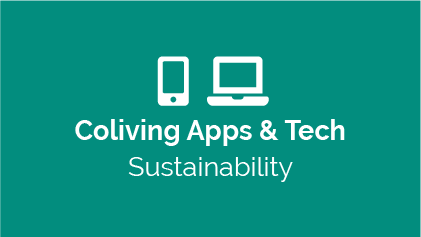
62.50% of respondents say they want features to reduce negative environmental impact and costs.
- Coliving Apps and Tech 2021 Survey
In addition, the (internationally agreed) Sustainable Development Goals (SDGs) from the United Nations also include doubling the global rate of improvement in energy efficiency by 2030, which affects buildings.
Staying ahead of the regulatory curve is only one of the reasons why sustainability features are key for operators to consider. An article on Creating Sustainable Cultures written by Penny Clark, Head of Research and Sustainability for Conscious Coliving, offers practical tips for enhancing sustainability in coliving spaces. See below to find out more.
Why is sustainability important for coliving operators?
Sustainability is important for coliving operators for three main reasons.
1) Cost savings: If you align yourself with a sustainability approach, you will be able to save costs through things such as reusing furniture, embedding circular economy strategies, resource sharing, and energy savings.
2) Strengthen community: Communities thrive around shared values and purpose. If you market (and actually align) yourself in sustainable ways, you will attract a certain group of residents who align with these values. When there is an alignment of value, people bond and grow stronger together as a community.
3) You become a role model: Finally, fostering sustainability measures is a sure way to place yourself as a forward-thinker and role model. Sooner or later, every coliving space will adopt sustainability measures (whether through a rise in consciousness or regulatory pressure), so whoever is already onboard is leading the way. This can be appealing for an ever-growing population of potential residents interested in living more sustainably.
Apps and tech for consumption reduction
Software and technology can help operators track, measure, and reduce their energy and other resource consumption levels. For example:
- Oroeco empowers users to calculate their daily carbon footprint based on transport, food and electricity consumption. This app also encourages community action through sharing and comparing.
- Flowbox helps operators monitor energy consumption, air quality, and CO2 levels.
- HYDRAO is a tool for water conservation that has an app. Other energy consumption saving apps include EnergySaver, EnergyTracker, OhmConnect, CodeGreen, and Nest.
- Amber Energy is a global utility company whose ‘Lean, Clean, Green’ services include analysis of energy data, consumption reduction strategies and sustainability accreditations.
Apps and tech that foster behavior change
A second way tech can enhance sustainability in coliving spaces is by nudging residents towards adopting more sustainable behaviour patterns. We list a few examples below:
- SDGs in Action, a United Nations app that helps users learn about and take action on the 17 Sustainable Development Goals.
- Refresh Go Green offers 52 tips and useful information to improve individual and planetary health.
- Joule Bug encourages users to go green through videos, games, and action-packed challenges.
Resident & Staff Wellbeing
The World Health Organization’s (WHO) defines health as: “a state of complete physical, mental and social wellbeing and not merely the absence of disease or infirmity”.
The UN International Covenant on Economic, Social and Cultural Rights also states that it “is the right of everyone to enjoy the highest attainable standard of physical and mental health”.
Fostering wellbeing in your coliving space is not only a societal responsibility. It also makes business sense.
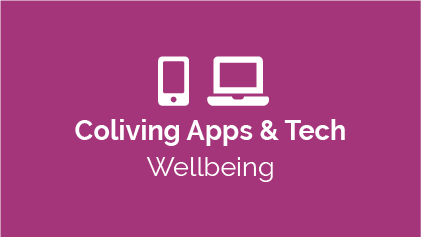
Wellbeing in coliving: a home where you can flourish mentally, emotionally and physically.
- Conscious Coliving Manifesto
This is because the happier your residents are, the less it is that they will leave.
Also, residents and staff who feel well typically take better care of themselves and others, and this puts less pressure on you as an operator. The section below outlines how apps can facilitate an improved sense of wellbeing for your staff and residents.
The apps in this section are categorized in correlation to three wellbeing indicators taken from the European Social Survey (ESS) that correspond closely to coliving: increased vitality, emotional stability, and positive relationships. We view these three indicators as being highly relevant to wellbeing in coliving.
Apps for Increasing Vitality
Vitality can be measured as perceived energy levels and apps can help enhance energy levels through the following ways:
- Promoting exercise and body movement. Some examples include yoga apps such as Yoga Studio or Asana Rebel, fitness apps such as ClassPass or Fit Bolt, and Seven and bike-sharing apps such as Mobike, Ofo, and Lime Bike.
- Guiding people to eat healthily and locally. Some examples include Nutrients, MyFitnessPal, and Farmer Direct.
- Encouraging good rest with sleep tracking apps such as SleepScore.
Apps for Enhancing Emotional Stability
Apps can support emotional stability in a myriad of ways, including:
- Encouraging the practice of mindfulness and meditation. Examples of apps for this are Insight Timer (a crowd-sourced meditation app featuring workshops, guided meditations, music, courses and celebrity speakers), Headspace (probably one of the most well-known wellbeing apps offering visualisation techniques, mindfulness and meditation, and guidance), and Calm (offering audios, imagery, music and mindfulness techniques).
- Offering mood-boosting techniques via apps such as Happify and ThinkUp.
- Tracking emotions and moods, especially regarding anxiety, depression, and bipolar disorder, with apps such as Daylio, Moodkit, Worry Watch, and eMoods.
Apps for Fostering Positive Relationships
Apps can help foster positive relationships by:
- Offering advice on relationship dynamics (e.g. via apps such as Healthy Relationships
- Teaching about nonviolent communication (with apps such as Pocket NVC and TimeForYou)
Communications
Easy and convenient communication is critical for nurturing the relationships upon which communities thrive.
According to the Coliving Apps and Tech Survey, 84.83% of respondents said they want private messaging among residents as an app feature. Other communication software features include messaging with staff and resident-led groups based on interest.
For operators, communication technology can greatly improve transparency and coordination.
While an ideal PMS + community software solution would include embedded communication channels, we offer a few alternative solutions or integration options below.
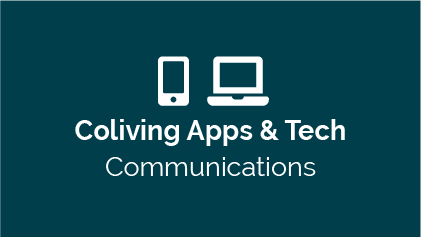
84.83% of coliving operator respondents say that they want a private messaging as an app feature.
- Coliving Apps & Tech 2021 Survey
Whatsapp was the most commonly listed among all the apps mentioned in the Coliving Mobile Apps Survey. If you run a small coliving community, this app or something similar may be all you need to meet communication needs. WhatsApp is a free and easy to use messaging service that allows users to create groups and send text and voice messages, images, files, and location.
However, the downsides of WhatsApp are that users can quickly become overwhelmed with the fast-paced correspondence of the platform and its lack of sub-channels for organizational purposes. Plus, WhatsApp is banned in some countries, including China.
Other Communications Solutions that can be explored
There are many other solutions we explored while creating this coliving software, apps and technology guide. Here are some:
- Slack is a messaging app for teams that includes topic channels, direct messaging, private groups, and file-sharing. It is important to note that Slack is designed as a workflow communications platform, not a community platform. Nonetheless, spaces like K9 use Slack for internal coordination, Embassy Network for their “doocracy” organization and Outsite for membership perks.
- Telegram and Signal are two other cloud-based messaging apps with similar functionality as Whatsapp but with more of a focus on privacy and security. Telegram has an open API for developers to create their own Telegram apps. Signal’s software is also free and open–source.
- OneRoof is a communication software and chat-based app that connects people living in the same building (not necessarily coliving building) to become a community, share information, organize events, and become more resourceful.
Finance and Accountancy
Every coliving operator faces practical tasks such as invoicing, budgeting, payment processes, inventory management, etc.
For residents of a shared living space, the financial and accountancy side of things can also be a headache.
Luckily there are several apps and platforms designed to automate these processes to create smoother operations and simplify tasks. Some PMS and community apps have such features included as part of their offer.
There are also several individual options as well. Click below to find out more about these.
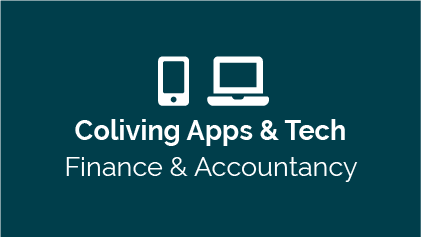
75% of respondents say they want payments and billing as an app feature"
- Coliving Apps & Tech 2021 Survey
Finance and accountancy solutions that can be explored
- Splitwise is a cost-splitter app that helps keep track of shared expenses and balances. You can record payments for things such as groceries and utility bills and then split them according to what is agreed upon among the users.
- Co-Budget is a collaborative tool that enables users to participate in resource allocation and decision-making by proposing projects and allocating funds to the proposals they like. The free version allows for unlimited users and up to 5 completed budgets.
- Paytm is India’s digital wallet and mobile payment service. It allows users to transfer money to bank accounts.
- GPay is a mobile wallet that Grameen Phone users in India can use to pay for bills, phone recharge, train ticketing, among other features.
- Acasa is a fantastic software tool specifically created for housemates to track expenses and split bills. The software company is currently going through a transition and is reducing its management of services, but it still allows users to track and split costs between housemates.
- Stripe is a software solution for accepting payments, sending payouts, and managing online businesses.
- QuickBooks is user-friendly accounting software that can automate tasks such as invoicing, time tracking, budgeting, inventory management.
Discovery, Booking & Roommate Matching
How can you be discovered by potential residents who want to live in your space?
One way is through discovery platforms. In this case, residents are typically looking for a living space based on type of coliving, location, costs, etc.
Another way is through roommate matching. Roommate matching platforms help residents find a space based on member personalities, values, interests, hobbies, etc.
Being on multiple platforms such as these allow you as an operator to gain more visibility.
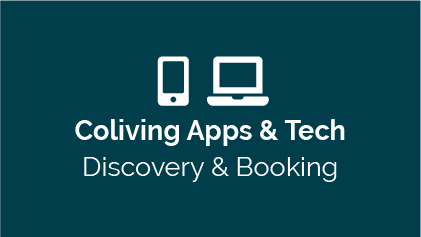
71.88% of coliving operator respondents say that they want a digital access solution for their coliving buildings.
- Coliving Apps & Tech 2021 Survey
Read below to find out about apps for each of these as well as platforms that facilitate the booking process of new residents to your space.
Discovery & Booking solutions
- Anyplace is a platform and mobile app that allows people to easily book fully furnished and flexible accommodation all over the world. They are currently operating in most major U.S. cities as well as in Europe, India, Asia, Mexico, and Canada. Many of the top featured places on Anyplace are coliving spaces
The following platforms do not currently have an app feature but are used by the industry:
- Coliving.com is a discovery and booking platform for coliving spaces including 16,000 bedrooms in 1,100 properties across 200 cities and 52 countries around the world. It allows potential residents to search for spaces according to location and then filter by dates, price, room type, and amenities.
- Convivo is an online discovery platform for coliving spaces, rental homes, and hostels across India.
- Floasis is a platform geared towards digital nomads to book local stays in nature with good wifi. Popular locations include Portugal, Spain, Greece, and France.
- Socialbookers is a platform that allows people to find a coliving space by creating a profile and filtering options according to personal preferences including type of space, vibes, activities, age range, and room size. Current coliving locations include spaces in Portugal and Spain.
- Young Global Living is a coliving platform that aims to make coliving more mainstream by making it easy to browse, select and book coliving options. People looking for a coliving home can put in their checkin and checkout date, preferred city, and then get a list of options to choose from.
We would also like to point out that Airbnb, while sometimes used by coliving operators, is a platform we do not recommend using for listing your space. The reasons for this are outlined in this article, and include things such as penalizations, short-term inquiries and difficulties around communicating values and the coliving experience.
Roommate Matching solutions
- Roomster has listings in more than 192 countries and 18 languages and connects potential roommates using personality traits, and keyword searches. Members can match based on testimonials from friends, hobbies, interests and questions answered through their profiles.
- SpareRoom What really sets SpareRoom apart from some other roommate apps is that it has a team of people that screen every ad on SpareRoom so you can ensure listings are safe and verified. This app also hosts “Speedroommating” events where you can meet up with people in your community and go through a roommate speed date-like process to see if you find someone who would be a good fit for your coliving community.
- Whoomies Available in France and London, Whoomies is a shared accommodation platform that allows users to publish their listing and receive and manage applications.
Section 6:
PropTech, ConTech, Co-Tech & Beyond
As we mentioned in the prelude and Section 1 of the Guide, This coliving software, apps and technology guide is mainly focused on web and mobile apps solutions for enhancing resident and community experience. But, this is all part of a larger conversation that includes many different digital transformations and technology solutions within real estate.
As the coliving industry grows, so do the coliving and real estate technology solutions. Some of these innovative solutions for real estate include PropTech, ConTech, CoTech and more.
What is PropTech?
According to Designing Buildings Wiki, PropTech is used to describe emerging startup technology companies that are influencing and disrupting the property market.
Generally considered the umbrella concept for the technologies, PropTech is used in property management and construction. Many of the software solutions featured in this guide can be considered some form of PropTech.
PropTech is primarily associated with pre-construction activities (such as property sales and leasing issues) along with post-construction tasks (such as operations and maintenance). The term PropTech is also often used in conjunction with ConTech, which we outline below.
To learn more about PropTech you can read this article from our partner, Spatial Experience. They give an overview of PropTech and showcase some innovative solutions such as SALTO KS.
What is ConTech?
ConTech broadly describes the intersection of construction and technology and can cover anything in the construction industry that is digitally connected.
This Forbes article describes ConTech as “the technology used to innovate the way we plan, design, and build structures, as well as the manufacture and installation of their components”.
Some ConTech solutions include the following:
- Communications technology: construction software and apps that can store and transmit drawings, documents, and specifications for on-site components.
- Augmented and virtual reality: using AR and VR for modelling purposes, site walkthroughs, stakeholder visualisations/engagement
- Drones: drone technology for site safety, security surveillance, gathering aerial data and site mapping.
- Prefabrication and 3D Printing: expediting construction processes and costs with the offsite prefabrication of materials and building components.
These are only a few examples of ConTech, but technology’s potential to enhance construction processes is huge. It can lead to significant cost savings and innovations in the sustainable development of our buildings and homes.
Co-Tech: The Future of Coliving Technology
In their recently published magazine ‘Co-Tech: Innovating Coliving with Technology,’ our partners at Coliving Insights cover technology innovations in the areas of ConTech, connectivity solutions, access control systems, PMS platforms, and more. This edition focuses on the innovative technology solutions that we can find within the real estate sector. It explores how technologies can enhance your overall experience, operations, profitability and sustainability.
Artificial intelligence, the Internet of Things, robotics, smart appliances and property management apps are just some of the topics covered.
By implementing user and community-centric approaches, PropTech, GreenTech, ConTech and Co-Tech solutions can genuinely impact user experience and operational efficiencies and ultimately increase sustainability, wellbeing, and community engagement.
Wrap Up:
Coliving Software, Tech & Apps: What's ahead?
In wrapping up this Guide on coliving software, apps & technology, we want to share a few final words with you about what’s ahead.
What's ahead: Consolidation of Software Solutions
As consolidation in the coliving market continues to occur, so will the consolidation of tech solutions. Not only will coliving operators continue to merge – such as in the cases of Starcity/Ollie (and now Common) and Habyt/Quarters/Homefully – but software and tech platforms may ultimately do so as well.
At the end of the day, many technology platforms and digital transformations aim to do the same thing. As the market matures, more and more of these solutions will join forces (i.e. Glynk and Cosine Labs) to create stronger and more bespoke offers for coliving developers and operators.
Maybe one day, there will even be an open-source technology platform to help foster thriving communities in an affordable and crowdsourced manner…
What's ahead: Digitally-Heavy vs Digitally Savvy
Until then, we can observe how coliving operators are positioning themselves as both PropTech and OpCos (operating companies)- sometimes, also mixed with a PropCo (a subsidiary company to manage an OpCo’s income-generating real estate).
Is it really possible to be a real estate developer and a technology service provider/developer?
It is hard to tell at this stage, but the real estate businesses who have spent a lot of energy positioning themselves as technology companies – and have subsequently received a lot of VC funding for it – have recently had difficulties (think lawsuit between WeWork and Softbank).
This question about whether operators should develop coliving software solutions themselves is important, especially while you are acquiring new sites, trying to ensure 95%+ occupancy and keeping your existing residents happy.
Interestingly enough, some operators are just using Salesforce as a base for all their technology integrations. So when thinking about developing technology as a coliving operator, maybe the question is more about being ‘digitally-savvy rather than ‘digitally-heavy’ (the same could be said about going asset-heavy or asset-light, depending on who you ask).
What this means in practice may require a few dozen conversations with some of the solutions mentioned in this guide to see if their business model is right for you as an operator. So with that said, what’s next with this Guide and you becoming a ‘digitally-savvy’ or a ‘digitally-heavy’ coliving operator?
What's ahead for you?
We hope you found this Guide useful and that you feel excited and empowered to really explore how to best leverage apps and tech into your coliving space.
If you haven’t filled out the Coliving Mobile Apps Survey yet, please do so. We would love to hear from more of you regarding your wishlist features. A second version of the Survey is also underway, with the support of some of our partners. Any feedback is also welcome to make the Coliving Apps, Software & Technology Guide as updated and useful for everyone in the industry as possible.
As an impact-driven coliving consultancy, we support our clients embed community, sustainability and wellbeing into the core of their strategies, experiences and designs.
The same goes for technology: we can support you as an operator to best understand your technology needs and refer you to our partners for specialised support. This software and technology guide is a step toward making that process just a bit easier for you.
We look forward to supporting you and the sector to thrive.
Let’s stay connected!
~Naima, Juan, and Matt
This guide has been co-authored for you by:
Transformational Coach and facilitator. Trainer in mindfulness, sharing circles, and how to live and lead more consciously. Co-author of the Community Facilitation Handbook and the Coliving Apps & Tech Guide. Facilitates community engagement strategies.
Juan is a Communications Strategist, Project Manager, Systems Engineer, Team Coach and Executive Coach with an ontological/systemic approach. Co-author of the Coliving Apps, Software & Tech Guide and contributor of The Community Facilitation Handbook. He facilitates connection for individuals, teams, and communities.
Matt is responsible for designing community experience and impact strategies and measuring the social value of coliving communities. Matt is also a founding member and current Head of Community of Co-Liv and has worked for The Collective on their Impact Team.
If you found this guide useful, please consider sharing it with others 😊 🙏
LinkedIn
Facebook
Twitter
Pinterest
